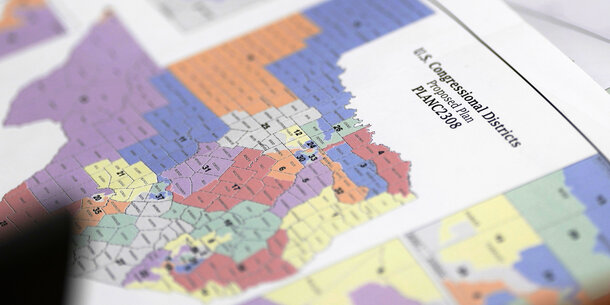This morning, in response to the third set of state legislative maps approved on party lines by the Ohio Redistricting Commission, the petitioners in Ohio Organizing Collaborative v. Ohio Redistricting Commission filed objections with the Supreme Court of Ohio, arguing that the new maps, like their predecessors, violate the Ohio constitution’s prohibitions against partisan gerrymandering. The petitioners ask the court to declare the most recent maps, adopted by the commission on February 24, invalid. They urge the court to take up the district plan that was submitted to the General Assembly by Professor Jonathan Rodden and which has district lines that meet constitutional standards. The petitioners ask the court to declare the Rodden plan valid and constitutional and order the commission to state whether it will enact the Rodden plan and, if not, why it refuses to do so.
The Brennan Center for Justice at NYU Law and Reed Smith represent the petitioners: the Ohio Organizing Collaborative, CAIR-Ohio, Ohio Environmental Council, Ahmad Aboukar, Crystal Bryant, Samuel Gresham Jr., Prentiss Haney, Mikayla Lee, and Pierrette “Petee” Talley.
“The commission has now defied multiple orders from the Ohio Supreme Court and doubled down on blatantly unfair maps. Enough is enough,” said Yurij Rudensky, senior counsel in the Democracy program at the Brennan Center for Justice. “This is a betrayal of Ohio’s voters, who deserve fair maps.”
The petitioners filed objections to the commission’s maps along with an expert report by Michael Latner, associate professor of political science at California Polytechnic State University. These objections are similar to prior filings submitted in response to the last set of maps from the commission.
First, the petitioners assert that the commission created its new plan primarily to favor Republicans and disfavor Democrats, in violation of the Ohio constitution, and that the commissioners did so by identifying districts that leaned Republican and then adjusted the district lines just enough to create districts that lean Democratic by an extremely small margin. The petitioners’ second objection is that the commissions’ maps aren’t proportionate to Ohio voters’ preferences.
The latest House map contains 54 districts that favor Republicans, 26 districts that favor Democrats, and 19 toss-up districts that both parties have an equal shot of winning. This means Republicans have more than double the number of favorable districts than Democrats. A small shift in voter preference toward the GOP would give the party nearly 75 percent of House seats. The Senate map shows similar manipulation and imbalance.
“The commission’s latest maps have too much in common with its previous efforts. Like the first and second plans, this one violates the Ohio constitution by building in a substantial advantage for one party,” said Patrick Yingling, partner at Reed Smith.
The objections filed with the court in Ohio Organizing Collaborative v. Ohio Redistricting Commission are here, along with the expert report and more background and documents related to the case.
Related resources:
- “Ohio Voters File Motion to Intervene in Federal Redistricting Suit that Would Impose Unfair Maps,” Brennan Center for Justice press release, Feb. 25, 2022
- “Ohio Supreme Court Orders Second Redrawing of Legislative Maps Due to Partisan Gerrymandering,” Brennan Center for Justice press release, Feb. 7, 2022
- “Victory for Ohioans: Ohio Supreme Court Throws Out Legislative Maps for Illegal Partisan Gerrymandering,” Brennan Center for Justice press release, Jan. 12, 2022
- “COVID Inequities Show Why Ohio’s Fair Map Mandate Must Not Be Ignored” by Jeniece Brock, policy and advocacy director, Ohio Organizing Collaborative
- “Ohio Take Note: Fairness Is a Universal Value” by Tala Dahbour, policy director, CAIR-Ohio
- “How Gerrymandering Contributes to Environmental Injustice” by Callia Téllez, environmental policy fellow, Ohio Environmental Council
- “Lawmaker’s ‘Rigged’ Map Would Steal Ohioans’ Right to Representation” by Kathleen Clyde and Greg Moore, co-chairs, Ohio Citizens Redistricting Commission
- “We’re Suing Ohio Over Its Gerrymandered Voting District Maps” by Alicia Bannon, Yurij Rudensky, and Julia Kirschenbaum, Brennan Center for Justice

